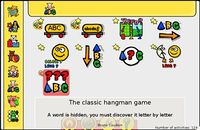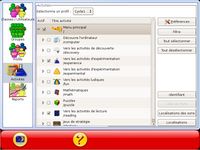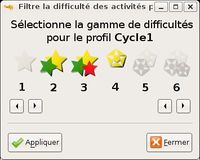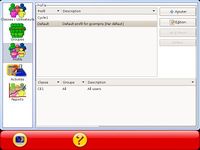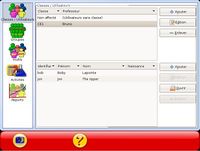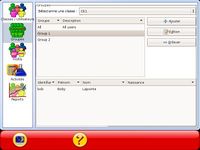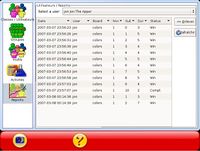Difference between revisions of "Manual"
m |
|||
| (11 intermediate revisions by 3 users not shown) | |||
| Line 1: | Line 1: | ||
{{TOCright}} | {{TOCright}} | ||
| + | |||
| + | =WARNING= | ||
| + | '''This page is about the old legacy version of Gcompris.''' | ||
| + | '''The manual for the new version is there: https://docs.kde.org/trunk5/en/gcompris/gcompris/index.html''' | ||
= Introduction = | = Introduction = | ||
| − | GCompris is completely free educational software suite which contains a wide range of activities. It offers various activities aimed at covering a variety of fields such as the functioning of the computer, | + | GCompris is a completely free educational software suite which contains a wide range of activities. It offers various activities aimed at covering a variety of fields such as the functioning of the computer, using the mouse and keyboard, general learning, reading, writing, foreign languages, algebra, as well as various activities such as memory and logic games, scientific experiments etc. |
| − | In GCompris you will find many individual software packages which together make up the complete GCompris suite of | + | In GCompris you will find many individual software packages which together make up the complete GCompris suite of activities. Unfortunately, it is difficult to follow and maintain them as each one offers different graphic interfaces which vary widely in quality. The purpose of GCompris is to provide a development platform for educational activities. GCompris is part of GNU project and is placed under the [http://www.gnu.org/licenses/gpl.html GPL license]. |
= Minimal configuration = | = Minimal configuration = | ||
* Processor : Pentium 3 500Mhz | * Processor : Pentium 3 500Mhz | ||
| − | * Memory (RAM) : | + | * Memory (RAM) : 512 Mega Bytes |
| + | * Disk : 400 Mega Bytes | ||
* Operating system : GNU/Linux, BSD, MacOSX, Windows | * Operating system : GNU/Linux, BSD, MacOSX, Windows | ||
* Video : '''A 3D card is NOT required'''. 32 bits color depth mandatory. | * Video : '''A 3D card is NOT required'''. 32 bits color depth mandatory. | ||
| Line 16: | Line 21: | ||
The software is delivered under several forms. Follow the process according to your case. | The software is delivered under several forms. Follow the process according to your case. | ||
| − | * GNU/Linux : Use the packages delivered by GNU/Linux. If GCompris is not packaged in your Linux distribution, please contact them to ask for the inclusion of GCompris in your Linux distribution. | + | * GNU/Linux : Use the packages delivered by your GNU/Linux distribution. You may have to install the package ''gcompris-sound-en'' to have the english voices. If GCompris is not packaged in your Linux distribution, please contact them to ask for the inclusion of GCompris in your Linux distribution. |
| − | * Windows : Delivered under a classic installer for Windows. | + | * Windows : Delivered under a classic installer for Windows. This version requires an activation code. |
| − | * MacOSX : | + | * MacOSX : Delivered under a classic installer. This version requires an activation code. |
= The user interface = | = The user interface = | ||
| Line 33: | Line 38: | ||
A simple click on the icon will lead you to an activity or a menu of activities. | A simple click on the icon will lead you to an activity or a menu of activities. | ||
| − | An icon indicates if a | + | An icon indicates if a functioning sound system is required for an activity : |
| − | * Soundspeaker : The audio files are | + | * Soundspeaker : The audio files are included for this activity. |
* Soundspeaker with a red cross : The audio files are not installed in the present language. | * Soundspeaker with a red cross : The audio files are not installed in the present language. | ||
| Line 43: | Line 48: | ||
* [[Image:Home.png|32 px]] Home - Leaves the current activity, returns to the previous menu. | * [[Image:Home.png|32 px]] Home - Leaves the current activity, returns to the previous menu. | ||
* [[Image:Button ok.png|32 px]] Thumb - Validate, confirm your answer. Some activities do not detect automatically whether or not the child has completed the task. In this case, you have to click on this icon. You can also use the "enter" key on your keyboard. | * [[Image:Button ok.png|32 px]] Thumb - Validate, confirm your answer. Some activities do not detect automatically whether or not the child has completed the task. In this case, you have to click on this icon. You can also use the "enter" key on your keyboard. | ||
| − | * [[Image:Level1.png|32 px]] Die - The present level is displayed. Click on the | + | * [[Image:Level1.png|32 px]] Die - The present level is displayed. Click on the die to select another level. Generally, the activities offer several levels whose numbers depend on the activity. In GCompris, it is possible to go to the next level without having completed the current level. |
* [[Image:Repeat.png|32 px]] Lips - Ask GCompris to repeat the question. | * [[Image:Repeat.png|32 px]] Lips - Ask GCompris to repeat the question. | ||
| − | * [[Image:Help.png|32 px]] | + | * [[Image:Help.png|32 px]] Question mark - Display the help dialog box. Sometimes, an activity can be too complex to be described easily in the description area. In this case, this function gives access to additional information. |
| − | * [[Image:Config.png|32 px]] Tool box - Configuration menu. The configuration | + | * [[Image:Config.png|32 px]] Tool box - Configuration menu. The configuration is saved in the user repository(Folder) under the name .config/gcompris/gcompris.conf. This is a text file which can be edited manually. |
* [[Image:About.png|32 px]] Tux and his plane - Information box on GCompris, presents the main contributors and the version of the software. | * [[Image:About.png|32 px]] Tux and his plane - Information box on GCompris, presents the main contributors and the version of the software. | ||
* [[Image:Button exit.png|32 px]] Night - Quit GCompris. You can also use the short cut on your keyboard 'ctrl-q'. | * [[Image:Button exit.png|32 px]] Night - Quit GCompris. You can also use the short cut on your keyboard 'ctrl-q'. | ||
| Line 57: | Line 62: | ||
* gcompris --disable-quit : disable the "quit" button. | * gcompris --disable-quit : disable the "quit" button. | ||
* gcompris --disable-config : disable the "configuration" button | * gcompris --disable-config : disable the "configuration" button | ||
| + | * gcompris --disable-level : disable the level button | ||
| − | + | These options can of course be combined. | |
== Keyboard shortcuts == | == Keyboard shortcuts == | ||
{| | {| | ||
| − | + | ! Shortcut | |
| − | + | ! Action | |
|- | |- | ||
| Escape or ctrl-w | | Escape or ctrl-w | ||
| Line 77: | Line 83: | ||
| ctrl-m | | ctrl-m | ||
| Toggle sound mute. | | Toggle sound mute. | ||
| + | |- | ||
| + | | ctrl-b | ||
| + | | Display or Hide the control bar. | ||
|} | |} | ||
| Line 209: | Line 218: | ||
To make the configuration global to all the users: | To make the configuration global to all the users: | ||
* You can copy your configuration file to /etc/gcompris.conf | * You can copy your configuration file to /etc/gcompris.conf | ||
| − | * You can run GCompris with the --config option passing it a fully qualified path to a file | + | * You can run GCompris with the --config-dir option passing it a fully qualified path to a directory containing the configuration file (it is created on first run if not found) |
To make all users using the same database, run GCompris with --database option passing it a file on a local directory or a networked folder. The users must have read and write access to this file. | To make all users using the same database, run GCompris with --database option passing it a file on a local directory or a networked folder. The users must have read and write access to this file. | ||
| − | You can create a desktop launcher for the children and pass in it the options you need (--config and/or --database). | + | You can create a desktop launcher for the children and pass in it the options you need (--config-dir and/or --database). |
You can create another desktop launcher for the teacher. It must include the --administration option and the --database that points to your database. | You can create another desktop launcher for the teacher. It must include the --administration option and the --database that points to your database. | ||
| Line 222: | Line 231: | ||
To make the configuration global to all the users: | To make the configuration global to all the users: | ||
* You can copy your configuration file to C:\Program Files\gcompris directory. | * You can copy your configuration file to C:\Program Files\gcompris directory. | ||
| − | * You can run GCompris with the --config option passing it a fully qualified path to a file | + | * You can run GCompris with the --config-dir option passing it a fully qualified path to a directory containing the configuration file (it is created on first run if not found) |
To make all users using the same database, run GCompris with --database option passing it a file on a local directory or a networked folder. The users must have read and write access to this file. | To make all users using the same database, run GCompris with --database option passing it a file on a local directory or a networked folder. The users must have read and write access to this file. | ||
| − | You can create a desktop launcher for the children and pass in it the options you need (--config and/or --database). Here's an example: "C:\Program Files\Gcompris\gcompris.exe" -b C:\Documents and Settings\All Users\gcconfig\gc.db | + | You can create a desktop launcher for the children and pass in it the options you need (--config-dir and/or --database). Here's an example: "C:\Program Files\Gcompris\gcompris.exe" -b C:\Documents and Settings\All Users\gcconfig\gc.db |
You can create another desktop launcher for the teacher. It must include the --administration option and the --database that points to your database. Here's an example: "C:\Program Files\Gcompris\gcompris.exe" -a -b C:\Documents and Settings\All Users\gcconfig\gc.db | You can create another desktop launcher for the teacher. It must include the --administration option and the --database that points to your database. Here's an example: "C:\Program Files\Gcompris\gcompris.exe" -a -b C:\Documents and Settings\All Users\gcconfig\gc.db | ||
| Line 238: | Line 247: | ||
To make the configuration global to all the users: | To make the configuration global to all the users: | ||
* You can copy your configuration file to C:\Program Files\gcompris directory or C:\Program Files (x86)\Gcompris. | * You can copy your configuration file to C:\Program Files\gcompris directory or C:\Program Files (x86)\Gcompris. | ||
| − | * You can run GCompris with the --config option passing it a fully qualified path to a file | + | * You can run GCompris with the --config-dir option passing it a fully qualified path to a directory containing the configuration file (it is created on first run if not found) |
To make all users using the same database, run GCompris with --database option passing it a file on a local directory or a networked folder. The users must have read and write access to this file. | To make all users using the same database, run GCompris with --database option passing it a file on a local directory or a networked folder. The users must have read and write access to this file. | ||
| − | You can create a desktop launcher for the children and pass in it the options you need (--config and/or --database). Here's an example: "C:\Program Files\Gcompris\gcompris.exe" -b C:\Users\Public\gcconfig\gc.db | + | You can create a desktop launcher for the children and pass in it the options you need (--config-dir and/or --database). Here's an example: "C:\Program Files\Gcompris\gcompris.exe" -b C:\Users\Public\gcconfig\gc.db |
You can create another desktop launcher for the teacher. It must include the --administration option and the --database that points to your database. Here's an example: "C:\Program Files\Gcompris\gcompris.exe" -a -b C:\Users\Public\gcconfig\gc.db | You can create another desktop launcher for the teacher. It must include the --administration option and the --database that points to your database. Here's an example: "C:\Program Files\Gcompris\gcompris.exe" -a -b C:\Users\Public\gcconfig\gc.db | ||
Latest revision as of 11:27, 4 June 2023
WARNING
This page is about the old legacy version of Gcompris. The manual for the new version is there: https://docs.kde.org/trunk5/en/gcompris/gcompris/index.html
Introduction
GCompris is a completely free educational software suite which contains a wide range of activities. It offers various activities aimed at covering a variety of fields such as the functioning of the computer, using the mouse and keyboard, general learning, reading, writing, foreign languages, algebra, as well as various activities such as memory and logic games, scientific experiments etc. In GCompris you will find many individual software packages which together make up the complete GCompris suite of activities. Unfortunately, it is difficult to follow and maintain them as each one offers different graphic interfaces which vary widely in quality. The purpose of GCompris is to provide a development platform for educational activities. GCompris is part of GNU project and is placed under the GPL license.
Minimal configuration
- Processor : Pentium 3 500Mhz
- Memory (RAM) : 512 Mega Bytes
- Disk : 400 Mega Bytes
- Operating system : GNU/Linux, BSD, MacOSX, Windows
- Video : A 3D card is NOT required. 32 bits color depth mandatory.
Installation
The software is delivered under several forms. Follow the process according to your case.
- GNU/Linux : Use the packages delivered by your GNU/Linux distribution. You may have to install the package gcompris-sound-en to have the english voices. If GCompris is not packaged in your Linux distribution, please contact them to ask for the inclusion of GCompris in your Linux distribution.
- Windows : Delivered under a classic installer for Windows. This version requires an activation code.
- MacOSX : Delivered under a classic installer. This version requires an activation code.
The user interface
The interface is designed for easy use by small children. GCompris is controlled with a mouse, it cannot be used without a mouse or a pointing system.
Main window
When you start the program, GCompris shows a graphic interface which presents the list of activities with a control bar at the bottom.
Each icon represents an activity. When the mouse is set on it, the activity is highlighted and the name, description and author of the activity are displayed in the description area.
Around each one, you can find small icons which give additional information about the activity. A simple click on the icon will lead you to an activity or a menu of activities.
An icon indicates if a functioning sound system is required for an activity :
- Soundspeaker : The audio files are included for this activity.
- Soundspeaker with a red cross : The audio files are not installed in the present language.
The stars indicates the age group for which each game is designed :
At the bottom of the screen there is a control bar for GCompris. The following icons are described below from the right to the left (the icons are only displayed if they are available in the activity) :
 Home - Leaves the current activity, returns to the previous menu.
Home - Leaves the current activity, returns to the previous menu. Thumb - Validate, confirm your answer. Some activities do not detect automatically whether or not the child has completed the task. In this case, you have to click on this icon. You can also use the "enter" key on your keyboard.
Thumb - Validate, confirm your answer. Some activities do not detect automatically whether or not the child has completed the task. In this case, you have to click on this icon. You can also use the "enter" key on your keyboard. Die - The present level is displayed. Click on the die to select another level. Generally, the activities offer several levels whose numbers depend on the activity. In GCompris, it is possible to go to the next level without having completed the current level.
Die - The present level is displayed. Click on the die to select another level. Generally, the activities offer several levels whose numbers depend on the activity. In GCompris, it is possible to go to the next level without having completed the current level. Lips - Ask GCompris to repeat the question.
Lips - Ask GCompris to repeat the question. Question mark - Display the help dialog box. Sometimes, an activity can be too complex to be described easily in the description area. In this case, this function gives access to additional information.
Question mark - Display the help dialog box. Sometimes, an activity can be too complex to be described easily in the description area. In this case, this function gives access to additional information. Tool box - Configuration menu. The configuration is saved in the user repository(Folder) under the name .config/gcompris/gcompris.conf. This is a text file which can be edited manually.
Tool box - Configuration menu. The configuration is saved in the user repository(Folder) under the name .config/gcompris/gcompris.conf. This is a text file which can be edited manually. Tux and his plane - Information box on GCompris, presents the main contributors and the version of the software.
Tux and his plane - Information box on GCompris, presents the main contributors and the version of the software. Night - Quit GCompris. You can also use the short cut on your keyboard 'ctrl-q'.
Night - Quit GCompris. You can also use the short cut on your keyboard 'ctrl-q'.
Kiosk mode
When you use GCompris with small children or on a self-service kiosk, you can disable a certain number of options :
- gcompris --disable-quit : disable the "quit" button.
- gcompris --disable-config : disable the "configuration" button
- gcompris --disable-level : disable the level button
These options can of course be combined.
Keyboard shortcuts
| Shortcut | Action |
|---|---|
| Escape or ctrl-w | Quit the current activity or dialog then return to the main menu. |
| ctrl-q | Quit GCompris without further notice. |
| ctrl-f | Toggle fullscreen mode. |
| ctrl-m | Toggle sound mute. |
| ctrl-b | Display or Hide the control bar. |
Notes on the internationalization
GCompris is internationalized and is available in more than 50 languages. If you want to check if your language is available, you can start GCompris and select your language in the option of configuration. Be careful, your operating system must support your language so that GCompris can use it. If you find a red cross while selecting a language in GCompris, this means that your system doesn't support it, even if a translation is available in GCompris.
On GNU/Linux, if your language is not available, select another language support on your distribution to add it. In most cases, you have to install an additional package 'locale-xx' or 'language-pack-xx' - xx is a language code such as 'En' for English -.
If your language is not supported, you can contribute to the software and add the translation of your language. If you are interested, you can contact the translation team of the Gnome project for your language.
You can check the level of translation for your language on the gnome web site.
Language learning
You can use GCompris in a foreign language that you are learning. Select a foreign language in the configuration Menu. Don't forget to install the optional audio modules for this language in your GNU/Linux distribution. Windows' version is provided with all audio support that are available. Whilst using GCompris in another language it is possible to configure some activities more precisely using the audio set through the administration module.
Customizing activities
Control Panels allow you to enrich the lexical content of activities to make them fit your needs.
In the activities of reading or math, you can add your own lists of words or numbers, and thus adapt the content of the activity to your curriculum.
Configuration table of the activity of vertical reading:
- Default: Indicates the default language of the activity that can be changed.
- Language: selects the language of the word list.
- Level: indicates the level of difficulty and allows the display of lists that you can complete and / or modify.
Administering GCompris
GCompris contains a very powerful administration module to assist in simplifying its use in schools. This module was designed to satisfy the many different ways of using GCompris in as simple a way as possible.
Activity selection
GCompris currently offers nearly a hundred different activities. It is not always sensible to offer all of the activities to children at once. One approach could be the introduction of the activities little by little as the children develop their skills. This will keep their curiosity alive and will avoid them losing time doing activities which may be too complex for them.
There are two different ways of selecting the activities :
- By levels or intervals of levels. In this case, you use GCompris'levels (1 to 6 stars), You can choose a specific level such as 1 star, or an interval of levels - from 2 to 4 stars -.
- By activity. In this mode, you can tick or tick out each activity or all the activities of a same section.
Profile creation
A profile permits the creation of a behaviour model of GCompris under a unique name. It is possible to create profiles without any links to users, groups or class.
If you want to use GCompris with children of different age groups, you can create a profile for each one. For each profile, you will be able to associate a set of activities.
For instance, it is possible to create a profile 'grade 1' or a profile 'grade 2'.
To launch the administration module, find the start menu on your desktop or on a command line with gcompris -a.
Using a profile
Start GCompris with the option --profile 'my profile' :
gcompris --profile 'cycle 1'
To get the list of existing profiles :
gcompris --profile-list
Of course to simplify the start of GCompris in a particular profile, the easiest is to create a new launcher for your desktop and to associate it to a command that include the correct options.
Activity configuration
The profiles exist mainly to specify a list of activities but you can also personalize the behaviour of each one whenever it is possible within the activity.
The activities marked with an icon ![]() can be directly configured in the administration module. For example, You can configure some activities to function in English.
can be directly configured in the administration module. For example, You can configure some activities to function in English.
User and class creation
If you want to set up a personalized recording system, you can create a user profile for each pupil. This option will permit them to enter their 'user name' when they start GCompris. GCompris will then record a list of activities the pupil has attempted and show whether or not the pupil has completed it. GCompris is very flexible, you can group all the pupils in the default class if you don't use GCompris in several classes. You can also create classes without mentioning pupils. It will give you the possibility to define profiles for your classes. [edit]
Groups creation
A group is a number of pupils from different classes. It is an optional function, you can use GCompris, create users and define profiles without creating any groups.
The creation of groups will help you if your functioning mode is based on user groups which are composed of small groups of classes but also of groups of children from the same class or even of children who have not been associated to a class.
Reporting
Each activity lets appear a bonus image when the child has accomplished it or not. GCompris keeps in its internal base all the results for each child or for the default user.
You can display the results for all the pupils or for one in particular. A button allows you to erase all the records.
Identification
If you have created user profiles in GCompris, and you start GCompris with a profile, a 'Log-in' screen will appear.
There are two identification modes : a 'list' mode where you have to find your name from a list of names. This mode can encourage the child read his name. The second mode asks the child to enter his name. It can help the child learn how to use the keyboard.
Networking / Multiple Users
If you administer a school network, you can overwrite the configuration options of your users with your own configuration. The instuctions bellows apply to a single system on which you want to share the configuration between several users or for different users on multiple computers. In the last case, you need to put the configuration files on a networked partition.
GCompris uses 2 disctincts files for its configuration:
- The file 'gcompris.conf' (configuration) contains end user specific choises like sound and screen preference.
- The file 'gcompris.db' (database) contains :
- The list of all the activities and their menu position.
- The user log, what activity was played, at what time and was it successfull.
- The users, classes, groups and profiles.
- The configuration of each activity.
To edit a configuration file, the easiest way is to create one from GCompris. Simply configure GCompris as you wish, quit it and copy the created configuration file into the system one. From it, you can then remove the options that you don't want to be compulsory.
Configuration file example:
music=1
fx=1
screensize=1
fullscreen=1
timer=1
key="default"
GNU / Linux
On GNU/Linux, the configuration file is in the user directory under ~/.config/gcompris/gcompris.conf
To make the configuration global to all the users:
- You can copy your configuration file to /etc/gcompris.conf
- You can run GCompris with the --config-dir option passing it a fully qualified path to a directory containing the configuration file (it is created on first run if not found)
To make all users using the same database, run GCompris with --database option passing it a file on a local directory or a networked folder. The users must have read and write access to this file.
You can create a desktop launcher for the children and pass in it the options you need (--config-dir and/or --database). You can create another desktop launcher for the teacher. It must include the --administration option and the --database that points to your database.
Windows XP / 2000
On Windows XP, the configuration file is in C:\Documents and Settings\YOUR USER\.config\gcompris\gcompris.conf
To make the configuration global to all the users:
- You can copy your configuration file to C:\Program Files\gcompris directory.
- You can run GCompris with the --config-dir option passing it a fully qualified path to a directory containing the configuration file (it is created on first run if not found)
To make all users using the same database, run GCompris with --database option passing it a file on a local directory or a networked folder. The users must have read and write access to this file.
You can create a desktop launcher for the children and pass in it the options you need (--config-dir and/or --database). Here's an example: "C:\Program Files\Gcompris\gcompris.exe" -b C:\Documents and Settings\All Users\gcconfig\gc.db
You can create another desktop launcher for the teacher. It must include the --administration option and the --database that points to your database. Here's an example: "C:\Program Files\Gcompris\gcompris.exe" -a -b C:\Documents and Settings\All Users\gcconfig\gc.db
SPECIAL NOTE: Due to a bug in XP, there is a possibility that users with limited access will not be able to write to the database. If this is happening to you, you will need to make those users to have administrator access.
Windows Vista / 7
On Windows Vista & 7, the configuration file is in C:\User\YOUR USER\.config\gcompris\gcompris.conf
To make the configuration global to all the users:
- You can copy your configuration file to C:\Program Files\gcompris directory or C:\Program Files (x86)\Gcompris.
- You can run GCompris with the --config-dir option passing it a fully qualified path to a directory containing the configuration file (it is created on first run if not found)
To make all users using the same database, run GCompris with --database option passing it a file on a local directory or a networked folder. The users must have read and write access to this file.
You can create a desktop launcher for the children and pass in it the options you need (--config-dir and/or --database). Here's an example: "C:\Program Files\Gcompris\gcompris.exe" -b C:\Users\Public\gcconfig\gc.db
You can create another desktop launcher for the teacher. It must include the --administration option and the --database that points to your database. Here's an example: "C:\Program Files\Gcompris\gcompris.exe" -a -b C:\Users\Public\gcconfig\gc.db
Activation key
On Windows, it makes sense to put at least the line 'key="your 6 digit key"' in a shared configuration file. This way, all users on this PC won't have to activate GCompris.
On school networks, you can simply copy this file using your deployment system.
Finally, the last step is to move the Gcompris Admin desktop icon from the All Users or Public desktop folder to the user's desktop folder that will be administering Gcompris. Make sure this user has Windows admin rights.
Portable GCompris
Portable software is a class of software that is suitable for use on portable drives such as a USB (thumb) drive or iPod, although any external hard drive could theoretically be used. The concept of carrying one's favored applications, utilities, and files on a portable drive for use on any computer is one which has evolved considerably in recent years.
GCompris can be made portable very easily by installing it on the target thumb drive and adding in its directory a gcompris.conf configuration file which includes a local user and configuration directory. The directory are specified as relative to the gcompris.exe binary.
Configuration file example:
user_dir="../My GCompris"
config_dir="../GCompris_config"
key="your 6 digit key if you have it"
Console Switches
Running GCompris from a command console with the --help option will display all the parameters it accepts:
- -f, --fullscreen run GCompris in fullscreen mode.
- -w, --window run GCompris in window mode.
- -s, --sound run GCompris with sound enabled.
- -m, --mute run GCompris without sound.
- -c, --cursor run GCompris with the default system cursor.
- -C, --nocursor run GCompris without cursor (touch screen mode).
- -d, --difficulty display only activities with this difficulty level.
- -D, --debug display debug informations on the console.
- -v, --version Print the version of gcompris
- -l, --root-menu Run GCompris with local menu (e.g -l /reading will let you play only activities in the reading directory, -l /strategy/connect4 only the connect4 activity). Use '-l list' to list all the availaible activities and their descriptions.
- -A, --package_data_dir GCompris will find the data dir in this directory
- -S, --package_skin_dir GCompris will find the skins in this directory
- -L, --plugin_dir GCompris will find the activity plugins in this directory
- -P, --python_plugin_dir GCompris will find the python activity in this directory
- --locale_dir GCompris will find the locale file (.mo translation) in this directory
- -M, --menu_dir GCompris will find the activities menu in this directory
- -a, --administration Run GCompris in administration and user-management mode
- -b, --database Use alternate database for profiles [$HOME/.config/gcompris/gcompris_sqlite.db]
- --create-db Create the alternate database for profiles
- --reread-menu Re-read XML Menus and store them in the database
- -p, --profile Set the profile to use. Use 'gcompris -a' to create profiles
- --profile-list List all available profiles. Use 'gcompris -a' to create profiles
- --config-dir Config directory location: [$HOME/.config/gcompris]. Alternate is to set $XDG_CONFIG_HOME.
- --user-dir The location of user directories: [$HOME/My GCompris]
- --experimental Run the experimental activities
- --disable-quit Disable the quit button
- --disable-config Disable the config button
- -g, --drag-mode Global drag and drop mode: normal, 2clicks, both. Default mode is normal.
- --nolockcheck Do not avoid the execution of multiple instances of GCompris.
- --no-zoom Disable maximization zoom
- --timing-base Increase activities timeout delays; useful values > 1.0; 1.0 to not change hardcoded value
- --timing-mult How activities timeout delays are growing for several actors; useful values < 1.0; 1.0 to not change hardcoded value
Windows Example
You can add these switches in the desktop icon properties. Here is an example that runs GCompris in kiosk mode in full screen given a specific database:
"C:\Program Files\Gcompris\gcompris.exe" -b C:\Users\Public\gcconfig\gc.db --disable-quit --disable-config -f
GNU/Linux
Create an application launcher and configure the command line parameters. Here is an example that runs GCompris in kiosk mode in full screen given a specific database:
gcompris -b /etc/gcompris/gc.db --disable-quit --disable-config -f
